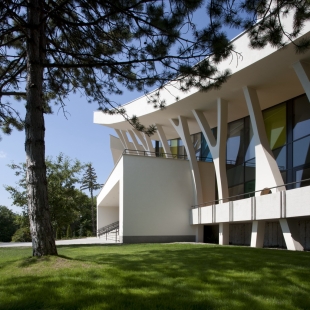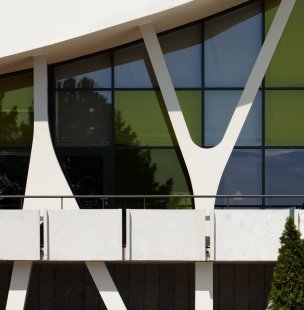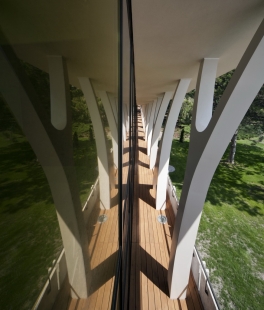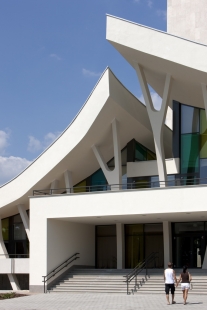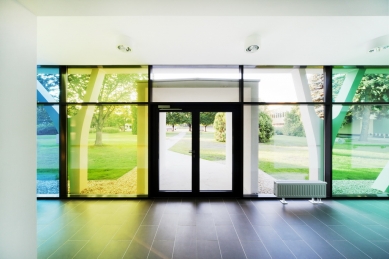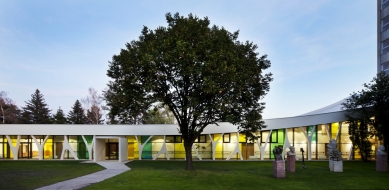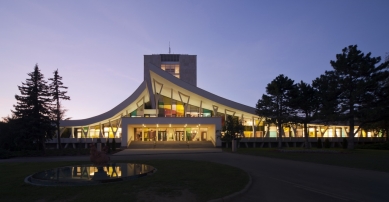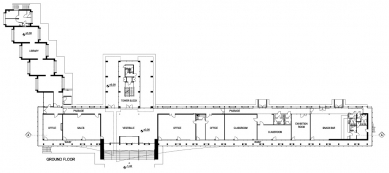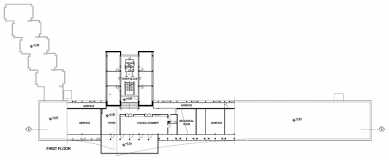
New Generation Center
Transformation and extension of the Central Building of Zánka

Current building
The main building of Zánka Next Generation Centre was built on the northern shore of Lake Balaton in the early 1970s, and its modernist style is typical of the era. Regarding architectural features, it is a composition of a long-stretching ground floor service building and a tower building located behind it. The simple, white limestone-covered kubus of the seven-story tower standing free at the youth centre's main entrance can be seen from a distance, reaching far above the crown of the surrounding trees. The main entrance of the building for public use is located on the southern side. The main entrance hall, reception, and sales and marketing offices are located on the ground floor of the service building. You may find the institution's library and a small museum room here, as well as a restaurant and a café in the eastern wing. The seven-storey office tower building contains service rooms, corridors, and a youth hostel.
Planned changes
Besides maintaining its original features, the tower has been completely redesigned inside and out. The electrical network, interior area coverings, doors, and windows have also been modernized. Guest rooms and offices have been renewed, and the total external stonework has also been renovated. The service building has not only been changed but expanded as well. Due to changing needs, we had to rationalize the existing features of the ground floor, but a completely new architectural element has also been added to the first floor of the building. In line with functional needs, a new meeting room was built here that is connected to the southern facade corridor with a staircase. The upstairs meeting room is supplied with a kitchen, a technical room, and a spacious south-facing terrace on the flat roof over the main entrance. The existing facility functions have been moved: the library and the museum area were transferred to the pavilioned west wing; IT, sales, and marketing offices were placed on the left side of the main entrance. During the internal transformation, new offices and computer classrooms were added to the longitudinal eastern side of the service building, and the catering area was renovated and given a new entrance. A new wind-sheltered front area and an entrance roof have been added to the main entrance of the central building. The building is accessible with a wheelchair via the leveled entrance of the tower.
Shaping the building facade
The new design of the house was enriched with a special design that retains the modernist details of the original building but at the same time humanizes it in a vivid continuation. It does not deny the existing features and the modern architecture of the building, but by understanding and continuing them, it relieves the architectural logic of transformation based on the existing forms; this way, a reinterpreted harmonious unity of values of the past and modern, expressionist architecture has been created. The most spectacular change in the building is embodied in the added floor of the ground floor service building, in which the modern shell structure appearance and the upturned roof resemble the waves of Balaton and balance the unity of the building. This is a new kind of dynamic component that recalls Lautner's or Niemeyer's free, sweeping ferro-concrete design style. The arch supports evoke the shapes of the surrounding water world in context with the landscape and the atmosphere of Lake Balaton. The upward and inverted "Y" stands create a regular rhythm with the green, yellow, and blue glass fields appearing here and there from behind the curtain wall, creating a homogeneous facade texture. The resulting horizontal facade duplication fills the redesigned horizontal building body with life and energy. The building was nominated for the European Union's Award of Contemporary Architecture, the Mies van der Rohe Award in 2013.
The main building of Zánka Next Generation Centre was built on the northern shore of Lake Balaton in the early 1970s, and its modernist style is typical of the era. Regarding architectural features, it is a composition of a long-stretching ground floor service building and a tower building located behind it. The simple, white limestone-covered kubus of the seven-story tower standing free at the youth centre's main entrance can be seen from a distance, reaching far above the crown of the surrounding trees. The main entrance of the building for public use is located on the southern side. The main entrance hall, reception, and sales and marketing offices are located on the ground floor of the service building. You may find the institution's library and a small museum room here, as well as a restaurant and a café in the eastern wing. The seven-storey office tower building contains service rooms, corridors, and a youth hostel.
Planned changes
Besides maintaining its original features, the tower has been completely redesigned inside and out. The electrical network, interior area coverings, doors, and windows have also been modernized. Guest rooms and offices have been renewed, and the total external stonework has also been renovated. The service building has not only been changed but expanded as well. Due to changing needs, we had to rationalize the existing features of the ground floor, but a completely new architectural element has also been added to the first floor of the building. In line with functional needs, a new meeting room was built here that is connected to the southern facade corridor with a staircase. The upstairs meeting room is supplied with a kitchen, a technical room, and a spacious south-facing terrace on the flat roof over the main entrance. The existing facility functions have been moved: the library and the museum area were transferred to the pavilioned west wing; IT, sales, and marketing offices were placed on the left side of the main entrance. During the internal transformation, new offices and computer classrooms were added to the longitudinal eastern side of the service building, and the catering area was renovated and given a new entrance. A new wind-sheltered front area and an entrance roof have been added to the main entrance of the central building. The building is accessible with a wheelchair via the leveled entrance of the tower.
Shaping the building facade
The new design of the house was enriched with a special design that retains the modernist details of the original building but at the same time humanizes it in a vivid continuation. It does not deny the existing features and the modern architecture of the building, but by understanding and continuing them, it relieves the architectural logic of transformation based on the existing forms; this way, a reinterpreted harmonious unity of values of the past and modern, expressionist architecture has been created. The most spectacular change in the building is embodied in the added floor of the ground floor service building, in which the modern shell structure appearance and the upturned roof resemble the waves of Balaton and balance the unity of the building. This is a new kind of dynamic component that recalls Lautner's or Niemeyer's free, sweeping ferro-concrete design style. The arch supports evoke the shapes of the surrounding water world in context with the landscape and the atmosphere of Lake Balaton. The upward and inverted "Y" stands create a regular rhythm with the green, yellow, and blue glass fields appearing here and there from behind the curtain wall, creating a homogeneous facade texture. The resulting horizontal facade duplication fills the redesigned horizontal building body with life and energy. The building was nominated for the European Union's Award of Contemporary Architecture, the Mies van der Rohe Award in 2013.
The English translation is powered by AI tool. Switch to Czech to view the original text source.
0 comments
add comment



